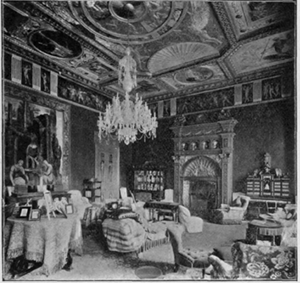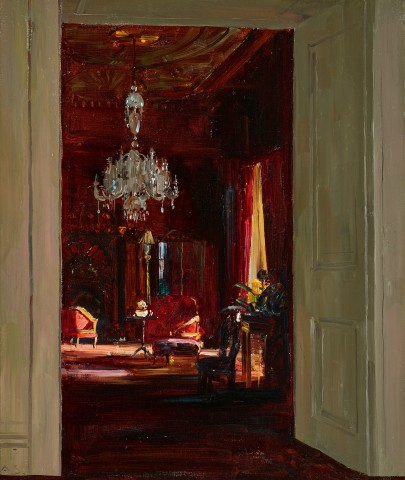INTERIOR, COMBE BANK, SEVENOAKS, c.1913
ARTHUR STREETON
oil on canvas
76.0 x 63.5 cm
signed with initials lower left: AS.
Probably Sir Robert Mond, Combe Bank, United Kingdom
Private collection
Tom Silver, Sydney
Private collection, Sydney
Thence by descent
Private collection, Melbourne
A Very Private Collection, S.H. Ervin Gallery, The National Trust Centre, Sydney, 15 June – 15 July 1990, cat. 64 (as ‘Interior Scene’)
When Arthur Streeton stayed the Easter of 1913 at Combe Bank, Sevenoaks in Kent, he described the memorable experience in a letter to a friend: grand dining, ‘Billiards, golf, fishing, shooting, “music”, peaches grapes flowers – nothing wanting’.1 Famous houseguests over the earlier years had included Matthew Arnold, Charles Darwin and Oscar Wilde.The original Palladian villa had been designed and built by Roger Morris in1720 for John Campbell, future fourth Duke of Argyll. Over the years, different owners saw important alterations. During the ownership of Dr William Spottiswoode, President of the Royal Society, Walter Crane, was engaged to redecorate the saloon as a library. ‘The chimney breast I designed was a semi-classical structure in wood …’, Crane wrote.2 Rich in gold, silver and bronze with a striking gesso plaster ceiling, the frieze ‘of Amorini in procession or playing, carrying fruits and emblems..’. The fireplace is signed and dated 1880. Crane (1845-1915), a highly regarded British designer and illustrator was a leading figure in the Arts and Crafts Movement, a founder-member of the Art Workers’ Guild and the Arts and Crafts Exhibition Society.
Combe-Bank-Sevenoaks-the-Saloon.png

In 1907, Combe Bank estate was acquired by Ludwig Mond, prominent chemist, industrialist, philanthropist and art collector (including Streeton). His son Robert inherited the estate in 1909, in 1913 commissioning Streeton to paint: ‘.. a dozen landscapes of the place & surroundings to be hung in the house….’3 One of these, The Lake, Combe Bank (1913), is now in the collection of the National Gallery of Victoria, Melbourne. Interior, Combe Bank, Sevenoaks belongs to this time.
Streeton’s paintings of interiors are rare. Among over eleven hundred titles listed in his 1935 Catalogue, the word ‘interior’ occurs five times. Although few in number, they range widely in date and location. An early interior, Tambourine 1891 in the Joseph Brown Collection of the National Gallery of Victoria, shows Tom Roberts’ Melbourne studio of that time.4 London examples include the watercolour, Interior Artist’s Studio, St. John’s Wood, London,1913. The year 1913 was an important one for Streeton, being awarded an ‘Honourable Mention’ at Pittsburgh’s Carnegie Institute, for his oil The Artist’s Dining Room.
Interior, Combe Bank, Sevenoaks, c.1913 spotlights Crane’s decorations as one of its special features. Stage like in presentation, the invitingly open doors provide a proscium arch, revealing the sparkling play of light across curtains, furniture and the grand chandelier which appears in the early saloon photograph illustrated here. Streeton moved from the acclaimed master of light-filled landscapes to capture the sparkle of light indoors, acknowledging, with Crane, its one-time owner. ‘Dr. Spottiswoode [Crane wrote] was also the first, I think, to use the electric light for domestic purposes.’5
1. Arthur Streeton letter to Walter Pring, London, 30 March 1913, in Galbally, A. and Gray, A., Letters from Smike, the Letters of Arthur Streeton, Oxford University Press, Melbourne, 1989, p.125
2. Crane, W., An Artist’s Reminiscences, The Macmillan Company, New York, 1907, p. 191
3. Streeton letter to Pring, op. cit.
4. The title comes from having been painted on a tambourine5. Crane, op. cit, p. 192
DAVID THOMAS
